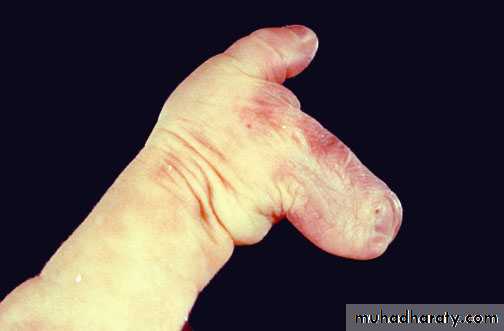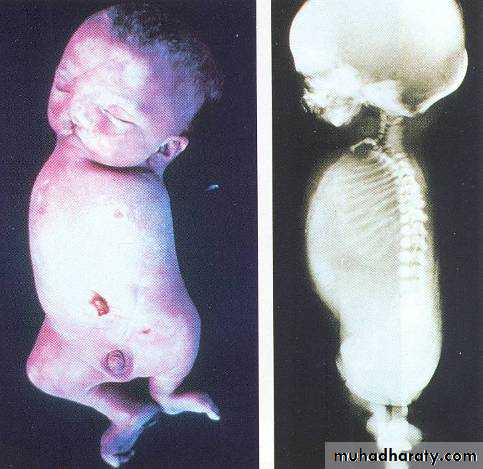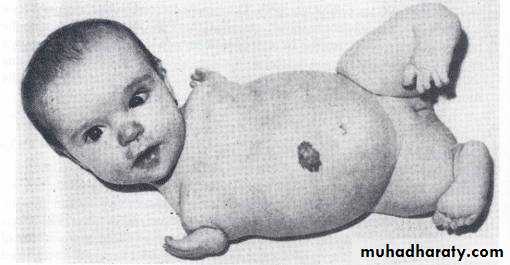Congenital abnormalities
These are morphological defects that are present at birth
It estimated that about 3% of newborns have a major malformation which causes 20-25% of infant dying in perinatal period
Moreover they continue to be a significant cause of illness, disability & death throughout the early years of life
• Malformations
• Intrinsic abnormalities occurring during the early developmental process,• either it involve single body system or causes multiple malformations
Causes of congenital malformations
A/Genetic
1-Chromosomal aberrations:
This is present in about 10-15% of a live infants with congenital malformations (abnormality either in number or structure of chromosome)
Example Down syndrome, Klinefelter syndrome, Turner syndrome.
Many of these cytogenetic aberrations arise as defects in gametogenesis & so are not familial. However, several can passed from one generation to the next
2-Mendelian inheritance (single gene mutations):
This is present in 2-10% of a malformed live birth
Approximately 90% are inherited as autosomal dominant or recessive, while the remainder segregate in an X-linked pattern
Example Marfan syndrome, mucopolysaccharidoses
B/Environmental:
1-Maternal/Placental infectionsPresent in 2-3% of malformed live births
Rubella
Cytomegalovirus
HIV
Syphilis
Toxoplasmosis
With all these infections the gestational age at which the infection occurs in the mother is critically important. The incidence of malformation caused by Rubella decrease from 50% to 20% to 7% in 1st, 2nd, & 3rd trimester
2-Maternal disease states
It represent 6-8% of malformed live births
Diabetes result in fetal macrosomia & diabetes embryopathyPhenylketonuria
Endocrinopathies3-Drugs & chemicals
Seen in 1% of malformed living birthsAlcohol
Folic acid antagonists
Androgens
Phyenytoin
Thalidomide
Warfarin
13-cis-retinoic acid
4-Irradiation
Seen in 1% of malformed living births
in addition to being mutagenic and carcinogenic, it is teratogenic. Exposure to high level of radiation during the period of organogenesis leads to malformations, such as microcephily, blindness, skull defects, spina bifida, and other deformities.
C/ Multifactorial (multiple genes +/- environment)
Cause 20-25% of malformed living birthsExample cleft lip, cleft palate & congenital dislocation of the hip
D/UnknownRepresent 40-60% of malformed living births
• Deformations:
• In contrast to malformation it arise later in fetal life & represent an alteration in the form or structure resulting from mechanical factors.• The causes can be divided into
• Maternal factors:
First pregnancy
Small uterus
Malformed (biocornuate) uterus
Leiomyomas
• Fetal OR placental factors
Oligohydramnios
Multiple fetuses
Abnormal fetal presentation
• Disruptions:
• This main error in morphogenesis resulting from secondary destruction of or interference with an organ or body region that was previously normal in development.• Causes are either extrinsic or intrinsic factors example amniotic bands result from rupture of amnion during fetal life may compress, attach to or encircle parts(limbs, hip, faces) of the developing fetus
Syndrome:
Refer to a collection of specific congenital anomalies believed to be pathologically related and typically seen together without any obvious single initiated defecate.Syndromes are most often caused by a single etiologic agent, such as a viral infection or specific chromosomal abnormality that simultaneously affects several tissues.
Mechanism of Malformations
The pathogenesis of these is complex & still poorly understood,The timing of teratogenic insult has an important impact on the occurrence & the type of malformation produce
Between 3rd & 9th weeks the embryo is extremely susceptible to teratogenesis and the peak sensitivity is the fourth & fifth weeks
In the fetal period (9th weeks to birth) fetus is susceptible to growth retardation & injury to already formed organs
• Perinatal infections
• In general fetal & perinatal infections are acquired via one of two primary routes
• Transcervical (ascending)
• Transplacentally (hematologic)
• Occasionally, infections occur by a combination of the 2 routes
• 1-Transcervical (ascending) infections
• Include most bacterial & a few viral (e.g., HSV-II)
• Such infections may be acquired in utero or around the time of birth
• Occurs by inhaling of infected amniotic fluid into the lungs or by passing through an infected birth canal during delivery
• Pneumonia, sepsis & meningitis are the most common sequelae
2-Transplacental (hematologic) infections
Most parasitic & viral infection & a few bacterial (e.g., Listeria, Treponema)These gain access to the fetal blood stream transplacentally via the chorionic villi
Infections may occur at any time during gestation or occasionally, as may be the case with hepatitis B & HIV at time of delivery via maternal to fetal transfusion
TORCHES infections (Toxoplasma, Rubella, Cytomegalovirus, Herpes virus, Syphilis, Other bacterial & viral agents)
Causes fever, encephalitis, chorioretinitis, hepato-splenomegaly, pneumonitis, myocarditis, hemolytic anemia, growth & mental retardation, cataracts, bone defects







